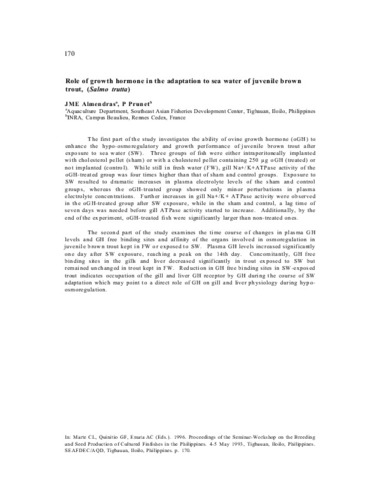A statistical power analysis of the 'internal reference' technique for comparing growth and growth depensation of tilapia strains
| dc.contributor.author | Basiao, Zubaida U. | |
| dc.contributor.author | Doyle, R. W. | |
| dc.contributor.author | Arago, A. L. | |
| dc.date.accessioned | 2013-04-08T03:01:58Z | |
| dc.date.available | 2013-04-08T03:01:58Z | |
| dc.date.issued | 1996 | |
| dc.identifier.citation | Basiao, Z. U., Doyle, R. W., & Arago, A. L. (1996). A statistical power analysis of the 'internal reference' technique for comparing growth and growth depensation of tilapia strains. Journal of Fish Biology, 49(2), 277–286. | en |
| dc.identifier.issn | 0022-1112 | |
| dc.identifier.uri | http://hdl.handle.net/10862/1551 | |
| dc.description.abstract | Experiments were conducted to compare the growth and growth compensation of three strains of juvenile Oreochromis niloticus. Ten full sib families (10 replicates) per strain were split and grown under crowded and uncrowded conditions for 3 weeks (the treatment). Both treatments were then grown an additional 12 weeks under less crowded conditions (the compensation). Standard length measurements were made at the end of crowding and the end of compensation. Each replicate included a size-matched control population of a fourth (red) reference strain. ANCOVA with the reference strain used as a cofactor revealed significant strain effects on specific growth throughout the experiment. The reference strain removed most of the random among-replicate error variance as shown by an increase of r 2 from 0.06 to 0.91 when it was included in the statistical models. If the reference fish had not been used, approximately 450 replicate families would have been needed to achieve the sensitivity of the present experiment (a difference of 7% among strains significant at P=0.05). We conclude that the CLSU strain grows significantly more slowly than the Israel and NIFI strains under the experimental conditions, that the crowding effect was essentially eliminated after 12 weeks of compensation, and that the reference strain greatly improved the resolution of the strain-testing experiment. | en |
| dc.language.iso | en | en |
| dc.publisher | Wiley-Blackwell | en |
| dc.subject | Oreochromis niloticus | en |
| dc.title | A statistical power analysis of the 'internal reference' technique for comparing growth and growth depensation of tilapia strains | en |
| dc.type | Article | en |
| dc.identifier.doi | 10.1111/j.1095-8649.1996.tb00023.x | |
| dc.citation.volume | 49 | |
| dc.citation.issue | 2 | |
| dc.citation.spage | 277 | |
| dc.citation.epage | 286 | |
| dc.citation.journalTitle | Journal of Fish Biology | en |
| seafdecaqd.library.callnumber | VF SJ 0504 | |
| seafdecaqd.databank.controlnumber | 1996-21 | |
| dc.subject.asfa | genetics | en |
| dc.subject.asfa | growth | en |
| dc.subject.asfa | population genetics | en |
| dc.subject.asfa | statistical analysis | en |
Files in this item
| Files | Size | Format | View |
|---|---|---|---|
|
There are no files associated with this item. |
|||
This item appears in the following Collection(s)
-
Journal Articles [1256]
These papers were contributed by Department staff to various national and international journals.




